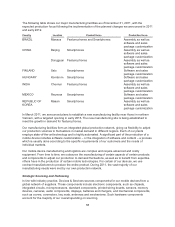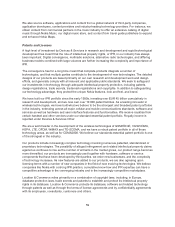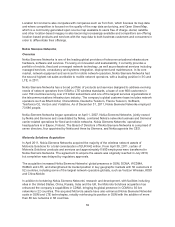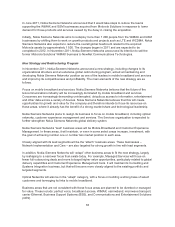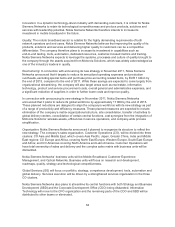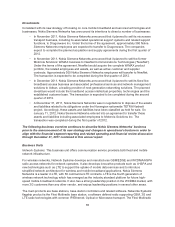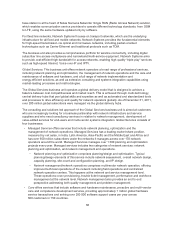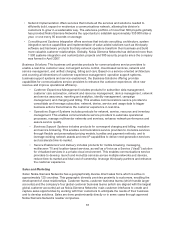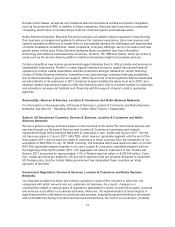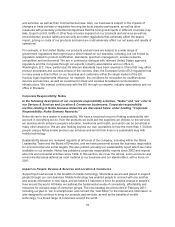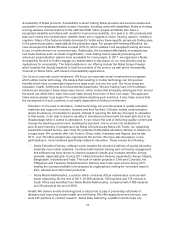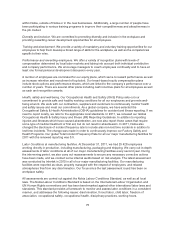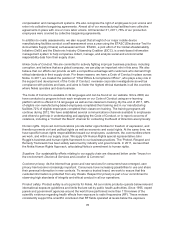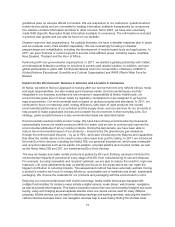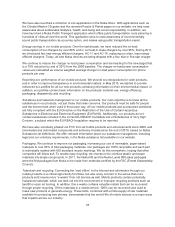Nokia 2011 Annual Report Download - page 70
Download and view the complete annual report
Please find page 70 of the 2011 Nokia annual report below. You can navigate through the pages in the report by either clicking on the pages listed below, or by using the keyword search tool below to find specific information within the annual report.Typically, orders are placed with Nokia Siemens Networks directly or following a formalized “Request
for Proposal” process involving several potential vendors. Orders received may be for immediate short-
term deliveries or for significantly longer periods covering, for example, a full network rollout with
network implementation or even performed on a turnkey project basis. Quite often, a framework
agreement will be established under which specific deliveries and services are called up over time.
Managed services contracts are generally long-term, typically for five years or more.
Sales Organization: The Customer Operation unit oversees and executes sales and product marketing
at Nokia Siemens Networks. Since January 1, 2011, the Customer Operations unit has been organized
around two regional clusters: East (which covers the APAC, Greater China, India, Japan and Middle
East regions) and West (which covers Africa, Latin America, North America, North East Europe, South
East Europe and West Europe).
Cross-regionally, specialist sales teams focus on the products and services offered by Nokia Siemens
Networks’ three business units. The global customer business teams are Deutsche Telecom, France
Telecom/Orange, Telefónica and Vodafone. Below the regional level, Customer Operations unit is
structured using sub-regions or customer business teams, with the customer teams at the customer
interface aligned to specific customers or groups of customers.
Marketing: The marketing and corporate affairs unit of Nokia Siemens Networks is responsible for
developing, executing and measuring the corporate marketing strategy, plan and budget. It develops
content, executes and measures corporate marketing programs and events that raise the visibility of
the Nokia Siemens Networks brand, seeks to position Nokia Siemens Networks as a thought leader in
the telecoms industry and promotes its portfolio of products, solutions and services to communications
service providers and public and corporate customers. It works in close collaboration with the regional
marketing teams, sales, the business units, the corporate strategy team and human resources.
Production
Nokia Siemens Networks’ operations unit handles the supply chain management of all Nokia Siemens
Networks’ hardware, software and original equipment manufacturer (OEM) products. This includes
supply planning, manufacturing, distribution, procurement, logistics, demand/supply network design
and delivery capability creation in product programs.
At the end of 2011, Nokia Siemens Networks had ten manufacturing facilities worldwide: five in China
(Beijing, Shanghai, Tianjin, Hangzhou and Suzhou), one in Finland (Oulu), two in Germany (Berlin and
Bruchsal), and two in India (Kolkata and Chennai). The Tianjiin and Hangzhou sites were acquired as
part of the Motorola Solutions acquisition.
In April 2010, Nokia Siemens Networks started manufacturing of 3G mobile communications
infrastructure at its Chennai facility to enable key customers in India to roll out 3G services faster. With
this, Nokia Siemens Networks became the first vendor of telecommunications infrastructure to
manufacture 3G products locally in India.
Nokia Siemens Networks works with best-in-class manufacturing service suppliers to increase its
flexibility and optimize costs. Approximately 29% of Nokia Siemens Networks’ production is
outsourced.
Certain components and sub-assemblies for Nokia Siemens Networks’ products, such as company
specific integrated circuits and radio frequency components, are sourced and manufactured by third-
party suppliers. Nokia Siemens Networks then assembles these components and sub-assemblies into
final products and solutions. For selected products and solutions, suppliers deliver goods directly to
68


